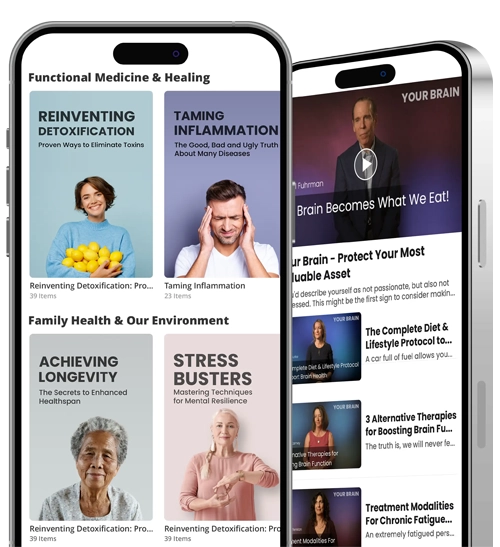The Dangerous Effects of Food Cues on Our Brains [A NEW STUDY]
Home
 Blog
Blog
 Health
Health
 Organs & Systems
Organs & Systems
 Nervous System
Nervous System
 The Dangerous Effects of Food Cues on Our Brains [A NEW STUDY]
The Dangerous Effects of Food Cues on Our Brains [A NEW STUDY]

We’ve all heard the expression, “You are what you eat.” Here’s a new one for you: “You eat what you see.”
Drive around your town, and you’ll find it littered with images of delicious-looking foods. From billboards advertising your local fast food chain bus stop ads of fancy restaurants to wall-sized images of sizzling steaks, it’s hard to avoid all the food advertisements popular in America today. It’s even harder when you smell that grilled steak or hear the pop of a soda can!
The problem is, the more delicious these foods look, smell, and sound, the more likely you are to want to eat them. Even worse, they’re likely the WRONG choice for your health!
Food Cues and Your Brain
A study from the University of Michigan took a closer look at the effects food cues have on our brains.
Food cues are described as “images, sounds, and smells that can prompt a sudden desire to eat or drink certain foods.” A study as far back as 1997 found that food cues were enough to cause restrained eaters to over-eat, increasing cravings for and liking of the food that was cued.
This new study involved 112 college students, all of whom were assigned randomly to one of two locales:
-
A neutral lab space.
-
A fast food lab. This space was designed like a proper fast food restaurant, with booths, tables, chairs, and even ambient music to sell the “vibe”.
All of the participants were instructed to eat lunch one hour before the study began. When they arrived at their designated locations, they received a certain number of tokens to spend however they saw fit. Tokens could be used to purchase fast food-style food items, including milkshakes, cheeseburgers, French fries, sodas, and more. They could also be used to play video games or buy time for alternative, non-food-related activities.
Get FREE Access!
We are on a mission to change your life by providing you with curated science-backed health tips, nutrition advice and mouth-watering recipes. Sign up to receive your 3 starter gifts and get exclusive access to new weekly content for FREE:

Free eBook
to boost metabolism

4 Shopping Guides
for every diet

22 Free Recipes
to beat sugar addiction

Subscribe now
As expected, those in the fast food lab space—exposed to the food cues common to being in a restaurant—felt hungrier than those in the neutral lab space. They tended to eat up to 220 more calories than those in the neutral space. However, despite their increased hunger, the food cues didn’t increase their enjoyment of the food any more.
Interestingly enough, the neutral lab space tried to use the same cues for the video games. The options to play video games were displayed on TV screens, and participants were allowed to choose their activity or food as desired. The various cues for the video games didn’t work to enhance the desire for the games. The food cues also didn’t enhance enjoyment of or desire for the games. The cues only work when it comes to food.
Breaking It Down
This study focused on the three important aspects of human eating:
Hunger – This is the biological imperative that drives us to eat. It is usually driven by our body’s need for energy and nutrients. Our bodies will tell us when we feel hunger.
Wanting – This craving or desire for food is sometimes driven by hunger, but it’s often as much psychological as physiological. Emotional eating is very common in our society, thanks to the addictive and stimulating nature of sweets, chocolates, salty snacks, and other “comfort foods”.
Liking – We may want food, but our desire for that food may not have any effect on our enjoyment of that food—as this study proved. Even though the food cues made the students want to eat more, they didn’t actually enjoy their food any more.
Just because you feel the craving for a food, that doesn’t mean you’re actually hungry. And, if you give into the craving and eat the food, it may not satisfy your craving because it won’t be as enjoyable as the temporary desire convinced you that it would be.
Understanding this distinction is vital in our fight to combat obesity, overeating, and cravings in our modern food-driven society. As the lead author of the study said, “Food-related cues can make people want or crave food more, but don’t have as much of an impact on their liking, or the pleasure they get from eating the food.”
What does this mean for you? As the author of the study said, “It is hard it is to avoid food cues in our current environment, but people can try some strategies to minimize their exposure by not going into restaurants and using technology to skip food advertisements in TV shows.”
It’s up to you to find ways to avoid being exposed to those food cues. And, once you are exposed, fight that desire or craving because now you know the truth: it’s just your brain’s response to the visual, olfactory, and auditory stimulation!
For other nutritional tips and science-backed truths, join ZONIA video streaming platform today where our health and nutrition experts provide easy to follow advice and recommendations on how to kick start your transformation!

We created ZONIA because we believe that everyone deserves to be empowered with the education and tools to be healthy and happy. Zonia's original videos and personalized transformation programs by our health & wellness experts will help you achieve this mission. Click on the button below to get started today:






